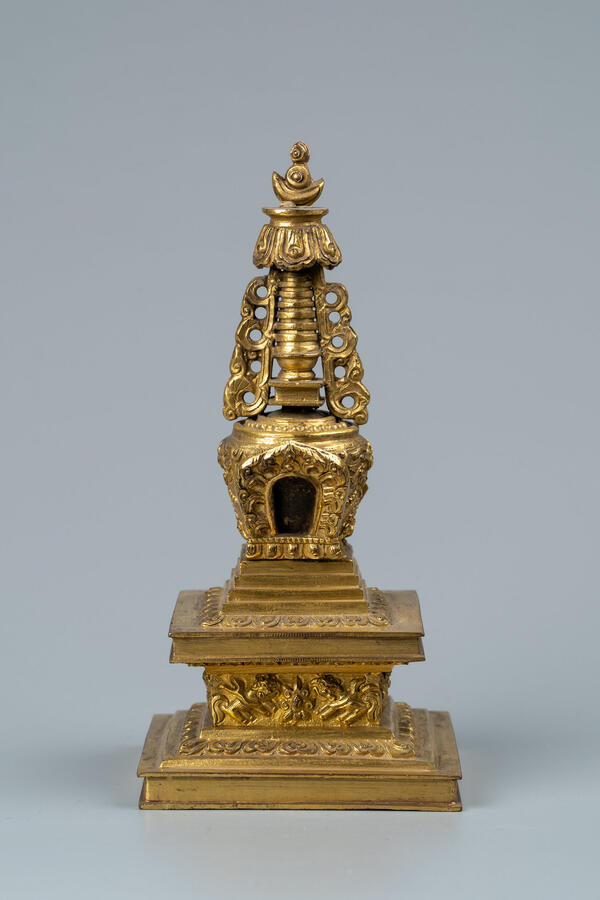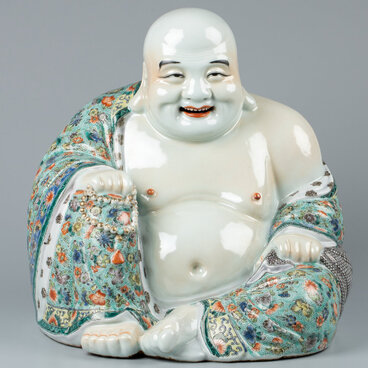The Samara Regional Art Museum displays a number of Buddhist art examples from different Asian countries, which were previously housed in the collection of the prominent orientalist Aleksei Matveevich Pozdneev. A stupa, or, as it is also called in the Republic of Buryatia, a suburgan, is a symbolic reminder of Buddha, a sacred architectural structure. The “Eastern Art” exhibition presents a smaller version of an ancient Buddhist stupa — a small copper sculpture.
According to Buddhist legends, stupas as commemorative structures built in honor of significant events appeared in India back during Buddha Shakyamuni’s lifetime. After Buddha’s departure to parinirvana (final nirvana), representatives of eight Indian clans divided his relics among themselves and built eight different stupas to honor the eight most memorable events of Buddha’s life.
The exhibit from the museum is modeled after the stupa of Enlightenment. This type of stupas is considered the main one, as it symbolizes the goal of Buddhist practices — the Enlightenment — the complete liberation from all human passions and sufferings. Despite its small size, the museum’s suburban echoes both the shape and all the symbolic details of the traditional suburgan. Conventionally, it is divided into three parts. The lower part of the stupa, its base, is called the stupa of Causes, it includes four steps. There are different interpretations of their symbolic meaning. For example, according to one version, the second step symbolizes the four great renunciations of non-virtuous actions, while the fourth and the top ones represent the five moral qualities: faith, perseverance, mindfulness, concentration and wisdom. The Lion Throne of Buddha made in the form of a square plinth is situated on top. The lion symbolizes Buddha’s fearlessness the spiritual path. The top of the suburgan is called the stupa of Results and denotes the end of the path, that is, the Enlightenment itself.
Buddhist stupas in different countries use different architectural solutions. The earliest stupas had a canonical three-part structure: a stepped base, a massive main section, and a top part similar to a multi-tiered umbrella. There are hemispherical, square stepped, tower-shaped, bell-shaped and bottle-shaped stupas. In Tibetan stupas, a symbol of fire, sun and moon — the Soyombo symbol — is installed at the top of the stupa.
According to Buddhist legends, stupas as commemorative structures built in honor of significant events appeared in India back during Buddha Shakyamuni’s lifetime. After Buddha’s departure to parinirvana (final nirvana), representatives of eight Indian clans divided his relics among themselves and built eight different stupas to honor the eight most memorable events of Buddha’s life.
The exhibit from the museum is modeled after the stupa of Enlightenment. This type of stupas is considered the main one, as it symbolizes the goal of Buddhist practices — the Enlightenment — the complete liberation from all human passions and sufferings. Despite its small size, the museum’s suburban echoes both the shape and all the symbolic details of the traditional suburgan. Conventionally, it is divided into three parts. The lower part of the stupa, its base, is called the stupa of Causes, it includes four steps. There are different interpretations of their symbolic meaning. For example, according to one version, the second step symbolizes the four great renunciations of non-virtuous actions, while the fourth and the top ones represent the five moral qualities: faith, perseverance, mindfulness, concentration and wisdom. The Lion Throne of Buddha made in the form of a square plinth is situated on top. The lion symbolizes Buddha’s fearlessness the spiritual path. The top of the suburgan is called the stupa of Results and denotes the end of the path, that is, the Enlightenment itself.
Buddhist stupas in different countries use different architectural solutions. The earliest stupas had a canonical three-part structure: a stepped base, a massive main section, and a top part similar to a multi-tiered umbrella. There are hemispherical, square stepped, tower-shaped, bell-shaped and bottle-shaped stupas. In Tibetan stupas, a symbol of fire, sun and moon — the Soyombo symbol — is installed at the top of the stupa.






